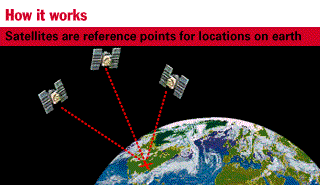 Survey receivers beat the system by starting with
the pseudo random code and then move on to measurements based on the carrier frequency for
that code. This carrier frequency is much higher so its pulses are much closer together
and therefore more accurate.
If you're rusty on the subject of carrier frequencies consider your car radio. When you
tune to 94.7 on the dial you're locking on to a carrier frequency that's 94.7 MHz.
Obviously we can't hear sounds at 94 million cycles a second. The music we hear is a
modulation (or change) in this carrier frequency. So when you hear someone sing an
"A" note on the radio you're actually hearing the 94.7 MHz carrier frequency
being varied at a 440 cycle rate.
GPS works in the same way. The pseudo random code has a bit rate of about 1 MHz but its
carrier frequency has a cycle rate of over a GHz (which is 1000 times faster!)
At the speed of light the 1.57 GHz GPS signal has a wavelength of roughly twenty
centimeters, so the carrier signal can act as a much more accurate reference than the
pseudo random code by itself. And if we can get to within one percent of perfect phase
like we do with code-phase receivers we'd have 3 or 4 millimeter accuracy! Yeeow!
Continue |